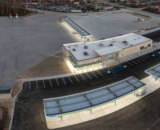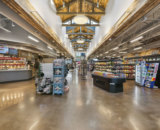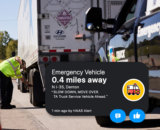Providing the right product, in the right place at the right time can help truckstop and travel plaza operators better meet their customers’ needs and drive sales. Truckstop and travel plaza operators and are getting innovative to ensure they have right mix of products, messaging and displays that will move product out of their stores.
Take Control of Contracts
Chris Harris, Retail Strategies, cautions retailers to put customers first. “A retailer’s job is to satisfy the customer. The supplier’s job is to sell more of their products to the customer and they will do that at the cost of other products,” Harris said. “Suppliers often push the brand agenda over the sales agenda.”
“When we work with a customer, we get them off of those contracts and we replace them with retailer-led agreements,” Harris said, noting that suppliers typically prefer their own contracts, so retailers have to be prepared when changing the agreements. Moving away from contracts can take up to three years, Harris said.
Dwight Gaiter, Johnson’s Corner Truckstop, Loveland, Colo., said the location moved away from contracts with key beverage suppliers and has seen sales increase since he took control of his cooler. He made the switch in January and by the end of summer his sales were up 11 percent and his gross profit had increased 9 percent.
“We’re selling the products that sell. We’re getting more turns out of the vault and I was able to bring in different lines from other companies that weren’t in the vault before,” Gaiter said.
Gaiter followed Harris’s suggestion and grouped like products together. “We did the scary thing of resetting the entire vault and not having a dedicated Pepsi and Coke door,” he said.
Typically when operators are under a contract, suppliers bring in their whole line of products. “They tell you what to put in and then they control the pricing for each item,” Gaiter said. “Now I choose what products to put in, I choose the pricing and then I choose the placement.”
Moving away from contracts wasn’t an easy decision. “It is a big risk because we’ve been constrained. All these years you have been told that you have to do everything the major brands tell you, but you really don’t,” Gaiter said. “They tell you the price will be higher if you’re not on contract, but it only took three or four months to get the promotions they said I wouldn’t get.”
Gaiter is getting pretty close to the prices he was getting before.
Connect to Customers
More retailers are using social media to research and sell products. Johnson’s Corner uses Facebook to gather customer input on its baked goods and will soon use it for retail. The location has hired a full-time employee to focus on social media.
Timothy Powell, Technomic, said some locations’ websites allow customers to calculate savings from loyalty programs and find discounts. Others offer free drinks to customers who check in via FourSquare, a mobile application that allows users to let friends know where they are.
Create Convenience
Whether it is banking at an ATM or checking themselves out at the grocery store, today’s consumers have become trained to do-it themselves. That mentality is carrying over into the c-stores and more and more locations are experimenting with selfserve kiosks at the pump or in the store to facilitate the sale of grab-and-go food items.
“The biggest reason we see this being a growth area is that c-stores are meant for convenience,” said Powell. “You can order food right at the pump, and I think we’re going to see more of that starting to occur.”
NATSO member Gilbarco Veeder-Root first introduced self-service food ordering kiosks in 2006. Earlier this year, Gilbarco joined with kiosk software developer Xpedient LLC to introduce new foodservice ordering solutions and enhance existing offerings. The new offerings allow retailers to manage their menu and screen content to optimize their foodservice. Customers with existing Gilbarco Express Ordering systems have the opportunity to upgrade their software, the companies said.
Getting customers to travel from the pump to inside the store can sometimes take extra persuasion. Gilbarco’s Applause Media System places video ads on pumps, with 10.4-inch interactive color screens with couponing capabilities.
“Advertising at the pump has the advantages of an undistracted consumer and full audio/video advertising capabilities with immediate calls to action,” said Mark Williams, Gilbarco Veeder-Root.
Surveys done during a pilot study of the system showed that 23 percent of the participants said they would go into the store for a purchase based on products advertised on the screens, and coupons printed noticeably increased in-store traffic and sales.
Once customers are inside a location, kiosks can help minimize wait times and ease the workload for cashiers. “The guy handling money isn’t the guy moving behind the foodservice area,” Powell said.
While kiosks can boost customer service and cut labor costs, they do require a capital investment, and can cost thousands of dollars.
Focus on Foodservice
When it comes to changing store layouts, more and more locations are putting food service front and center. “Some locations have painted their floors to move people to the foodservice area,” Powell said. “You’re seeing softer lighting and more comfortable décor that looks a little bit more like a fast casual restaurant. Darren Schulte, TSC Global, said expanding the grab-and-go food sections at locations can boost sales.
Johnson’s Corner did some remodeling to accommodate its foodservice offerings. “I have a dedicated section close to my fountains just for my fresh foods. It is all in one place and it is easy to get to,” Gaiter said.
Johnson’s Corner operates a full-service restaurant, so adding grab-and-go fresh foods to the c-store was easy. The location has added 10 to 15 fresh sandwiches and burritos in addition to lines of grab-and-go foods.
Adding breakfast items significantly boosted sales for Johnson’s Corner, which went from not having a breakfast program to offering 15 different hot breakfast sandwiches. “We’re selling about 400- 500 breakfast sandwiches a month. That is in addition to our burritos,” Gaiter said.
Schulte said operators should, at a minimum, consider adding a four-foot section of ready-to-eat breakfast items, such as breakfast cereals and bars.
Make it Semi Self-Serve
Even though customers are used to self serve, some operators are trying to improve customer service by adding staff to make sure customers are getting what they need.
Powell said some c-stores are utilizing a coffee hostess in the mornings. “They don’t pour your coffee, but they are there to greet you and they keep the process moving,” Powell said.
Dig Deep and Analyze SKUs
Each consumer audience has distinct needs and different shopping behavior, and Chuck White, DAS Inc., said today’s truckstops and travel plazas must provide products and solutions geared toward professional drivers, road warriors and leisure travelers. That means knowing which products and how many to carry is paramount.
White said, “More is not more. Often less is more. If we can rapidly attract and engage a consumer with a need or want-based solution, we create value through convenience …”
Schulte recommends operators take a close look at the number and variety of products they carry.
“Space is limited,” Schulte said. “I’ll tell them they have to carry the Frito Lay, but they don’t have to carry all of that item.
For operators Schulte worked with, the advice hit home. “I had way too many SKUs in like-type products. It was overkill in some areas,” said Tricia Howell, Truck N Travel TA.
Bill Vollenweider, Detroiter Travel Center, said, “You can have way too many SKUs and then what happens is your customers can’t find what they want and you can’t keep track of your inventory and because of that you’re costs go up.”
In fact, Schulte cautions that providing too many choices of like items can actually reduce profitability. “If a location has four sizes of something, most people will naturally get the smaller. If you only have available to you a 20-ounce soda, you’ll get a 20-ounce soda,” Schulte said.
The jury is out on exactly how many SKUs a location should carry.
“If they’re doing 10,000 gallons a day of diesel, they don’t need 5,000 SKUs. If you have 5,000 SKUs, something is suffering, and it is most likely the grocery side,” Schulte said.
However, unlike Schulte, Harris is a proponent of an increased number of SKUs.
“Most stores have about 3,000 SKUs. We recommend that there should be a significant more SKUs,” Harris said, adding that he is seeing 4,000 to 6,000 in stores. “More SKUs give you more chances to sell things to customers.”
Gaiter said since reviewing and revamping his products, the number of SKUs in his cold vault stayed the same, but now he offers more variety. On the grocery side, he has a few hundred additional SKUs.
Vollenweider said, “The most important thing I’ve learned is that you can’t be all things to all people. In the past that is what we’ve tried to do. Instead, you need to stick with your high-volume items.”
Group Products Together
Consumers like to compare products and grouping items together makes it easier for shoppers to find the right product for them, which in turn makes it easier for them to buy.
Consider the cooler, explained Harris. Different brands of orange juice might be spread across five cooler doors, but Harris recommends operators group all like-products together. What’s more, retailers should limit the number of off-location coolers they place within the store, which only ambushes sales from other products, he said.
“By putting all of your drinks in the cooler, you start to train your customer to walk through the store to the cooler category,” Harris said.
Grouping products together also builds power around the category. “The categories that have power are the categories that sell,” Harris said.
Try a Virtual Planogram
Trying new merchandising techniques can be time consuming, so some companies are turning to virtual research to test new planograms, shelf sets and SKU optimization.
“Virtual store research allows us to really see what something might look like in an environment without having to build something for real,” said Bob Gillespie, In Context Solutions.
In Context Solutions can build an online, virtual 3-D store that looks real and creates an immersive experience.
“You can look at what you already do and then move things around so you can see it visually. You can come up with three to four different ideas on marketing, promotions or displays,” Gillespie said. “Then we can have people shop it online and get analytical information about what is most effective.”
Cost varies depending on the scope of the project and number of active SKUs, but starts at around $20,000, Gillespie said. Because it is pricey, Gillespie said manufacturers were the early adopters of the technology.
He advised retailers to ask their suppliers to use the technology and provide the analysis.
He added, “They can say, ‘Look, it is disruptive to my business to be helping you test. Could you test this in the virtual world?’”
Tap Into the Power of Personality
The latest technology and most advanced ideas can give retailers a leg up, but operators also need to embrace who they are and let their personality shine through.
“A lot of times locations are trying to be like the guy across the street, and I push them not to do that. I ask them what they are known for and what they want to be known for,” Schulte said.
Gaiter said Johnson’s Corner is known for its cinnamon roll and he recommends operators find their own key offering. “You have to have some type of a signature item. If you don’t have one, make one up,” he said.
Analyze Customer Traffic Patterns
Just watching the way customers walk into and navigate a store can give operators a leg up in how they position their products.
“When they come in, how do they walk your store? If they come in and immediately take a left and make a beeline to the rest room, having the right product on that path, for example, cookies and crackers, will help grow your sales,” Schulte, said.
In his role with TSC Global, Schulte examines businesses at a micro level, which includes monitoring and analyzing customer traffic patterns.
Howell, recently reorganized her store after meeting with Schulte. “I put a better pattern to it so it is easier to walk around. I didn’t spend a boatload of money, but I made what I have work more efficiently,” she said.
Schulte said something as simple as angling gondolas differently can change the way customers come into the store and direct them to where you want them to go. He also advised operators to be careful about stacking too many items near the front of the store, which can create walls that stop customers from walking to the back of their store.
Schulte told Stop Watch other low-cost ways operators can change look and feel of a store is not to stack items in front of the windows, which will let more sunlight in, and to remove stand-alone fixtures in locations that look cluttered.
Rely on Cross Promotions
For years grocery stores have boosted sales by cross promoting items, and now other industries are following suit.
“Do simple things like putting bread next to peanut butter and jelly so the driver doesn’t have to go looking for it,” Schulte said. “You improve the shopping experience of the customer.”
Don Paddock, KSG Distributing, Inc., believes in the power of value-added promotions to drive sales. “We’re doing things like tying in new music CDs with a $5 gas card or buy a movie, get a bag of microwave popcorn,” he said. Not only is Paddock creating value for shoppers, he wants to create promotions that will entice them to spend more money.
|
This article originally ran in Stop Watch magazine. Stop Watch provides in-depth content to assist NATSO members in improving their travel plaza business operations and provides context on trends and news affecting the industry. The magazine is mailed to NATSO members bimonthly. If you are a member and not receiving Stop Watch, submit a request to be added to the mailing list. Not a member? Join today or submit a request to receive additional information. |
Subscribe to Updates
NATSO provides a breadth of information created to strengthen travel plazas’ ability to meet the needs of the travelling public in an age of disruption. This includes knowledge filled blog posts, articles and publications. If you would like to receive a digest of blog post and articles directly in your inbox, please provide your name, email and the frequency of the updates you want to receive the email digest.


